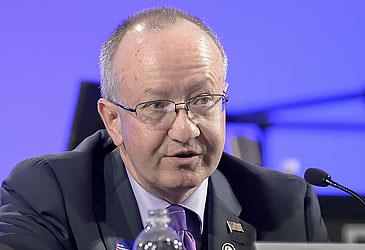A panel of physician experts offered three actions every physician can take to appropriately treat patients with acute or chronic pain. Presenting at the 2016 AMA Annual Meeting, they also discussed tools that can help keep patients safe from overdose and improve their quality of life.
The panel was comprised of physician representatives from the AMA Task Force to Reduce Prescription Opioid Abuse and one of the nation’s leading health policy experts.
In light of the opioid epidemic, the task force has put forth recommendations for physicians. “These recommendations come from our colleagues,” Patrice A. Harris, MD, psychiatrist and chair of the AMA Board of Trustees, said. “We are better physicians when we learn from one another.”
Dr. Harris said the task force is encouraging physicians to support comprehensive pain care and reduce the stigma associated with pain, reduce the stigma of substance use disorders, increase access to treatment and naloxone, and to use state PDMPs to make more informed prescribing decisions.
Using PDMPs to improve care
“[Guidelines] are useful to inform clinical judgement,” said Cynthia Reilly, director of the prescription drug abuse project at Pew Charitable Trusts, “but they alone will not reduce the harm that we see from opioids. Really, one of the challenges here is unless you are aware of medications that your patients may be receiving from other prescribers—even if you follow those guidelines to a ‘T’—the patient may still be at risk from harm.”
“PDMPs are one strategy to help with that,” Reilly said. “In an ideal world, a PDMP would be connected to … electronic health records (EHR) and other states. While efforts are underway to address that, we don’t have that yet.”
Frank Dowling, MD, clinical associate professor of psychiatry at SUNY at Stony Brook and medical director at Long Island Behavioral Medicine, said his state recently mandated PDMP use. The reason doctors are using the tool in New York is because the PDMP—called I-STOP—has the funding and technological support to make it useful. There were more than 18 million queries of I-STOP in 2015, according to the New York Department of Health.
This valuable tool is not just for when a physician plans to prescribe but can also aid in treatment. “Any time I’m assessing and making a treatment decision, I can look up that information that may be useful, even if I’m not going to prescribe,” Dr. Dowling said. “Some docs will look up all patients in their practice who may be on the schedule … others may look up only when they feel it’s clinically indicated because of a suspicion or a worry or they’re considering a prescription.”
“When using the PDMP in clinical care,” Dr. Dowling said, keep a couple of things in mind:
- “Stigma is high for people with pain and with a substance use disorder,” he said. “It’s even worse when they’re co-occurring. The info [from the PDMP] is a clinical tool; it’s an assist. It’s not a mandate that you must prescribe or not prescribe.” “Even with [patients] without a substance use disorder, aberrant behaviors are common,” he said. Patients may get scripts from other physicians or take more than they’re supposed to. They may need education on the matter or have “the reigns pulled in a little,” he said.
- Remember that the PDMP is a tool to use, “and it starts a conversation,” Dr. Dowling said. “In every unique patient that we all have, 80 percent of the time it’s very simple, 20 percent of the time it’s complex …. The information from your PDMP can be very useful.”
Managing chronic pain—focus on the patient’s goals
Treating patients with chronic, non-cancer pain comes down to the individual clinic visits and facing problems one-on-one with patients, said Erin Krebs, MD, medical director at the Women Veterans Comprehensive Health Center in Minneapolis. “What do we need to do that well?”
Dr. Krebs highlighted one of her patients, a woman with chronic back pain and multiple co-morbidities, including insomnia, fatigue, obesity, nausea and depression.
The patient’s prescription drug monitoring results showed that her use of the medications was appropriate. “There was no concern that this woman was misusing her medications,” she said. “But how is she doing?”
“Her pain and depression scores are persistently high,” Dr. Krebs said. “You can look at scores all day long, but ask her ‘how is pain affecting your life, or how is your day-to-day life going?’”
“She says, ‘I can’t leave the house very much; I can barely walk more than a block,’” Dr. Krebs said. “’My house is a mess; I’m not really cooking dinner anymore because I can’t stand at the stove long enough … I’m not even going to my kid’s activities anymore …. If I can do just one thing, I want to be a good mom.’”
“So what are the tools you need to help this woman?” Dr. Krebs asked. “Technology helps, but it comes down to a lot of other things. From my perspective, I need time with this woman. I need visits that are more than twice a year …. I need a team that’s going to help me.”
“This is really what it comes down to on a one-to-one basis,” she said. “We’re going to have to turn this around one patient at a time and help each patient manage their pain—get their life back and avoid avoidable risk.”
Dr. Krebs offered some advice for dealing with patients whose pain seems to persist. “I think the key thing is to keep focusing and refocusing on what the patient’s goals are, not [just] the pain intensity,” she said. “What does she care about and how can I get her closer to achieving what she cares about, because that’s a positive conversation that you can have at every visit.”
“This is my line,” she said, “‘I’m your cheerleader and your coach. I’m not going to promise a cure for this problem, but I’m going to be here every time you come in, and I’m going to talk to you about this and try to help you figure out how you can change your life to get closer to where you want to be.’”

Naloxone as a conversation starter
Robert Rich, MD, a family medicine specialist in North Carolina, offered advice on the use of naloxone and detailed the role he plays as a family physician.
In 2008, Project Lazarus was started in Wilkes County, N.C., which is a rural county that was dealing with one of the highest per capita overdose rates in the country. Project Lazarus developed a take-home naloxone overdose kit that contains two needle-free syringes of naloxone, two nasal adapters, a DVD instructional video and guides for patients on how to talk to their families about overdose.
“I use the Project Lazarus discussion as a way to introduce my concern to the patient that they may have a lot of medical problems, which may increase their risk of overdose,” Dr. Rich said. “I’m trying to say, ‘Let’s do something to help manage your risk; here’s another tool to help you do that.’”
“I’m saying, ‘I’m concerned about your overall health and well-being,’” he said, “‘not being judgmental at all …. I want to do something to help you.’”
Naloxone also can be a way to start the broader conversation about the risks that opioid medications carry without contributing to the stigma that surrounds overdose and substance use disorders.






